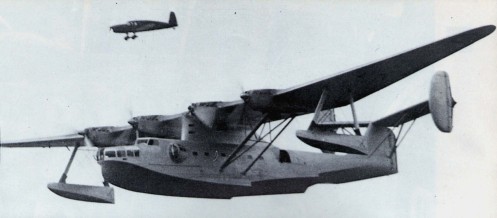 |
Site en Français
|
|
Potez-CAMS 141"Antares"

Technical
Specifications
|
Type
|
Patrol metal seaplane,
high wing monoplane
|
Date first flight
|
January
21, 1938
|
|
Wingspan
|
41,00 m
|
Lenght
|
24,31 m
|
|
Height
|
7,85 m
|
Wing Area
|
171,10 m2
|
|
Empty Weight
|
15031 Kg
|
Max. Takeoff Weight
|
26055 Kg
|
|
Cruising Speed
|
260 km/h.
|
Maximum Speed
|
320 km/h at 1000m
|
|
Climbing Speed
|
|
Service ceilling
|
5500m
|
|
Range
|
6000 kms
|
Crew
|
From 9 to 12
Men
|
|
Motorization
|
4 Engines
Hispano-Suiza 12Y-26/27 12 cyl V-cooled water, 937h each takeoff.
|
|
Armament
|
1 machine gun Darne
of 7.5mm in turret dorsal
2x 7.5mm Darne machine guns in the side posts behind the
cockpit
2x 7.5mm Darne machine guns in the side posts at the rear
of the fuselage
1500 kg of bombs
|
Only one Potez-CAMS 141
was manufactured before the German invasion. It is registered
FW-071
In May 1935, the Aéronautique
Navale issued a program to provide the Navy with a long-range reconnaissance
seaplane to replace the aging Breguet 521 Bizerte. Three aircraft
took part in the competition: the Latécoère 611, the
Breguet 730 and the Potez-CAMS 141. It was the latter that won the
competition. The Potez-CAMS-141 was designed by the design offices
of the Chantiers AéroMaritimes de la Seine (CAMS, which has
belonged to the Potez Company since 1933). The new seaplane was
equipped with a high wing perched on a short central mast and reinforced
by a lattice of reinforcements under each wing. The hull, of double-deck
steel construction, ended with a large bi-directional tailplane.
Two stabilizing floats were located under each wing. The defensive
armament consisted of 5 Darne 7.5mm machine guns distributed in
lateral posts on the fuselage and in a dorsal turret. The latter
replaced the 20mm gun initially planned. It could carry an offensive
charge of 1500kg. The crew consisted between 9 and 12 men. The prototype
was built in the workshops of Sartrouville and then transported
to Caudebec-en-Caux where it made its first flight on January 21,
1938. Following these first manufacturer tests, some modifications
will be made in the front part of the fuselage in order to improve
its hydro-dynamic qualities. The aircraft starts its official tests
in Saint-Raphael in the summer of the same year.
Once the tests were completed, the prototype named Antarès
was assigned to the E8 Squadron in September 1939 and was engaged
for a first mission in the Atlantic at the end of the month. The
Navy will order 4 and then 15 other copies, which were to be delivered
at the rate of 2 aircraft per month from June 1940. But these orders
will be reduced, then cancelled, the pressure of events imposing
new priorities.
At the Armistice, only the Antares was in service, and it was transferred
to Morocco at Port-Lyautey. She was then assigned to the 4E Squadron
in Dakar, within the Vichy Navy. In September 1940, he took part
in the protection of the battleship Richelieu during the attack
of Dakar by the British on September 24th and 25th, and during these
fights, he shot down a Fairey Swordfish, a Royal Navy torpedo biplane.
On November 8, 1942, after the Allied landings in North Africa,
the seaplane "Antarès" joined the Free French Forces
and carried out surveillance missions over the South and South Atlantic.
During one of these missions, in June 1943, the Antares sank the
German submarine U-105, causing the loss of 65 German sailors.
Due to lack of spare parts, the seaplane will finally be retired
in 1944 after having flown 1800 hours.
Potez-CAMS 141 was produced
in only one copy
Bibliography
1 ) _ Larivière Editions
- From July to October 1991
- Le
Fana de L'Aviation No260-261-262-263 : "The Potez-CAMS
141 Antarès"
From Gérard BOUSQUET




|
Photos
Album
|









